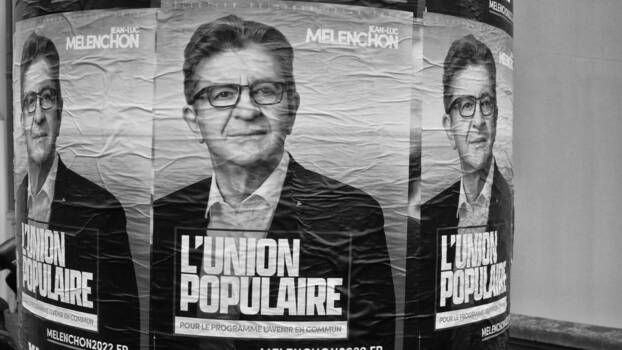
On Sunday, 10 April at 20:00, the two faces of Emmanuel Macron and Marine Le Pen appeared on French TV screens to announce their advance to the second round of the French presidential election. The incumbent president placed first with 27.8 percent of the vote, putting him slightly ahead of the far-right leader, who scored a record high of 23.1 percent. No matter what happens between now and 24 April, one of the two candidates will be the next President of France by the end of the month.
But for this picture to be entirely accurate, it needs to include Jean-Luc Mélenchon and the “Popular Union” he led, which finished third, neck-and-neck with Marine Le Pen and an all-time high result of 22 percent. Indeed, Mélenchon’s performance marks the best result for the radical Left in the history of the Fifth Republic — when all the ballots were counted, he was less than 500,000 votes short of making it to the second round.
Social Democracy’s Disastrous Decline
The trio left the rest of the candidates far behind, with far-right provocateur Éric Zemmour ultimately landing at 7.1 percent, making him the only other candidate who will have their campaign fees reimbursed by the state — a factor that may have an impact on the upcoming parliamentary elections in June.
Yannick Jadot, the Greens’ (EELV) candidate, scored a surprisingly low result of 4.6 percent despite polls indicating that climate change was among the most important issues for French voters. Meanwhile, the Socialist Party (PS) confirmed its dizzying plunge into irrelevance with 1.5 percent of the votes, surpassed by Fabien Roussel of the Communist Party (PCF), who reached 2.4 percent.
This polarized result underlines the continuity and acceleration of the dynamic witnessed five years ago with the implosion of France’s historical political parties parallel to Macron’s rise.
This time it is the traditional Right, with Valérie Pécresse of the Republicans (LR) and her 4.8 percent, that has been almost entirely crushed to the benefit of both Macron and the far-right embodied by Zemmour and Le Pen. They both now hold a far-right bloc encompassing more than 30 percent of voters. Against many odds, the majority of the left-wing electorate united behind Mélenchon and his Popular Union, profiting from the call for a “useful vote” on the Left and a programme that placed a strong emphasis on social justice and the ecological transformation of French society.
The rallying of social movement and environmentalist leaders behind Mélenchon, as well as strong support from a large portion of the feminist movement, probably played a role in in placing him first among voters aged 18–34. Nevertheless, the remaining divisions among left-wing and progressives forces prevented the movement from defeating Le Pen to face off against Macron and his neoliberal project in the second round.
An Uncertain Turn
Whether the second round will be the same as in 2017, however, appears much more uncertain. Macron’s reserve of potential second-round voters seems to be much shallower than it was last time around.
While Jadot, Roussel, and the Socialist Anne Hidalgo have called on their supporters to vote for Macron in the second round, their cumulative share of votes is less than 9 percent. As in 2017, Mélenchon issued a clear appeal to his supporters, stating only that “not a single vote” should be given to the far right.
How many of the 7 million people who voted for Jean-Luc Mélenchon will cast their vote for Emmanuel Macron, who will presumably try to lure them with various social and environmental campaign promises? This is difficult to predict, particularly given the strong opposition that Macron’s five years as president have generated among large swathes of the population.
At the opposite of the spectrum, Zemmour has called on his voters to support Marine Le Pen, who will also probably attract a significant part of Pécresse’s and Dupont Aignant’s supporters.
Ice Pick or Counter-Mobilization?
The strategy Macron’s government pursued for five years of pandering to far-right talking points and policies while portraying himself as the last bastion of republican defence against that very same far-right threat is revealing its dangerous limits.
It could even take the form of an ice pick that threatens to break the infamous “glass ceiling” over the far-right in France, making the prospect of Marine Le Pen becoming the next president of France a very tangible possibility.
Her chances are boosted by the fact that she has succeeded in portraying herself as a candidate with a solidly “social” agenda in contrast to Macron’s neoliberal destruction of what remains of the welfare state. This contrived and utterly false image could help her in attracting some of Mélenchon’s voters — despite a rise in Mélenchon’s vote share, Marine le Pen remains the leading candidate among working-class voters.
Finally, the fact that slightly more than one out of four potential voters did not vote at all is again a sign of the ongoing disaffection with mainstream politics among a large segment of the population. Their abstention somehow forms an indistinct “fourth estate” that may come to dictate the fate of French politics in the future.
Should potential voters’ disillusionment with the prospect of having the same choice as they did five years ago create a rise in abstention, it could be the crack in the glass ceiling that finally brings the far-right to power.